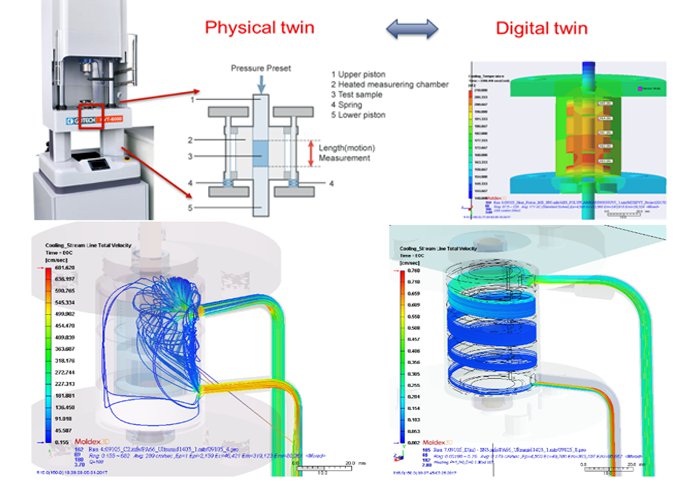
Digital Twin of Instrument Design and Material Measurement - Part 1
ESPECIALLY FOR OUR USERSThe accurate characterization of the different material properties of plastics, such as viscosity, pvT behavior and mechanical parameters for the process simulation of the injection molding process, represents a considerable challenge. To optimize the determination of material parameters, a digital twin can be implemented for both the development of measuring devices and the measurement method of plastic properties.
Due to the large variety of plastics and their different product and process requirements, the properties of the individual plastic types are different and in some cases unique. In injection molding it is of great importance to understand and accurately capture the material properties to implement them into a material model for process simulation. The most important physical properties in the processing of plastic molding compounds include rheological properties, pvT behavior, caloric and mechanical properties, and reaction kinetics in the crosslinking of thermosets. These material properties can be determined using established commercial measuring equipment such as capillary rheometers, rotational rheometers or measuring devices for differential scanning calorimetry (DDK), thermomechanical analysis (TMA) and dynamic mechanical analysis (DMA). With the steadily increasing demands regarding product quality and the higher simulation accuracy tied to it, the measuring range and the measuring accuracy of the measuring systems will inevitably increase. For example, as the product wall thickness decreases, the maximum shear rate in the filling phase increases, and this in turn leads to greater temperature differences in the plastic. Thus, the requirements for measuring the dependence of viscosity at higher shear rate limits and temperatures must increase.
With the rapid progress of computer technology and the development of numerical simulation methods, CAE analysis has become one of the necessary steps for product design and solving various process challenges in many industries. Furthermore, CAE technology offers the possibility of visualizing and optimizing the entirety of a measuring instrument, such as a capillary rheometer, during material measurement before it is released for production. We call this approach the "digital twin of the measuring instrument" and "digital twin of the material measurement".
Digital twin of a measuring instrument
Based on characteristic components of the measuring instrument under investigation, a digital model is created (the so-called "digital twin of the measuring instrument"). Using the example of a capillary rheometer, this digital twin offers the possibility to visualize on the basis of the numerical analysis different design designs for heating elements, capillary diameters, sensor positions, cooling channel layout, etc. during a material measurement. Furthermore, different heating powers and their effects on the material measurement can be investigated. Additionally, the changes of the individual components during the measurement process, such as thermal expansion and deformation of the chamber, can be determined by the digital twin of the measuring device. Thus, difficulties can be identified and corrected well in advance. The measuring instrument can be optimized for the intended use already in the design phase and the measuring accuracy and efficiency can still be guaranteed.
The digital material twin can be used to evaluate the change of material properties such as viscosity, pvT behavior, specific heat capacity, thermal conductivity, etc., as well as the evaluation of state changes such as pressure, thermal stress and temperature distribution, during the material measurement process.
To be continued … look forward to part two of our articles in which we will explain how the digital twin can be implemented for the measurement method of plastic properties …
